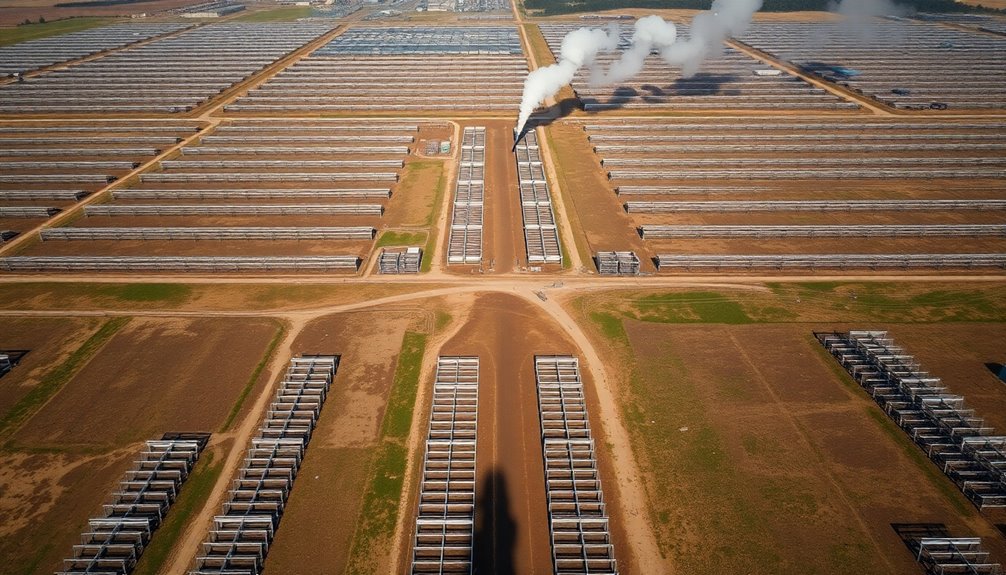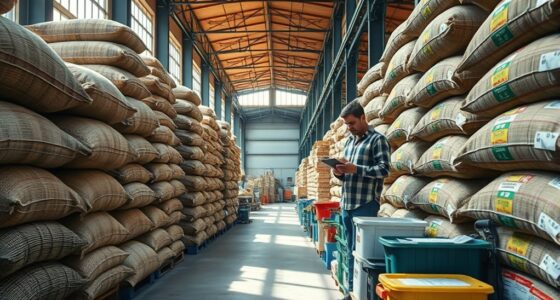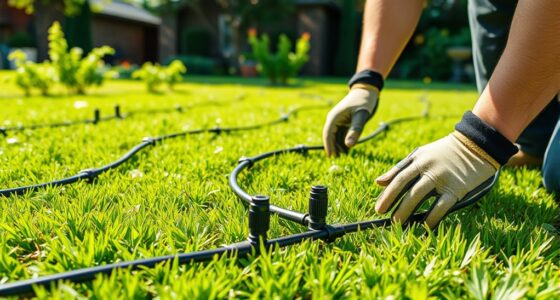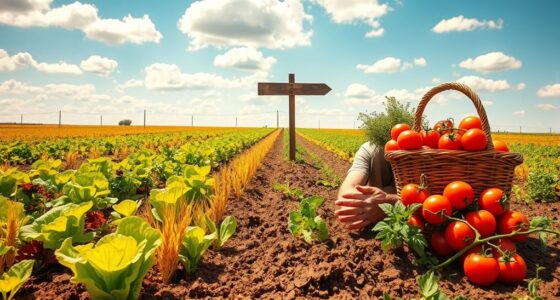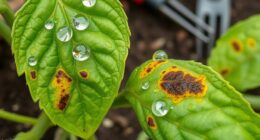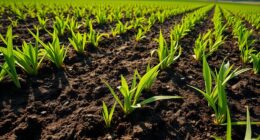Factory farming is a large-scale agricultural system focused on maximizing output while minimizing costs. You'll find that about 99% of farmed animals live in cramped conditions, which restricts their natural behaviors and causes stress. This method often leads to animal welfare issues, environmental pollution, and health risks related to antibiotic overuse. Corporate interests can overshadow ethical practices, harming both animals and small farmers. As you explore this topic further, you'll discover alternatives to factory farming that promote better animal treatment and healthier ecosystems, offering a glimpse into a more sustainable future for agriculture.
Key Takeaways
- Factory farming is an industrial agriculture method that confines 99% of farmed animals in small cages, restricting their natural behaviors and causing stress.
- Common practices in factory farming include painful mutilations performed without anesthesia, contributing to severe animal welfare concerns.
- This method significantly pollutes water and emits greenhouse gases, exacerbating climate change and harming local ecosystems.
- The overuse of antibiotics in factory farming leads to antibiotic-resistant bacteria, posing health risks to humans and animals alike.
- Economic pressures from corporate dominance drive small farmers out of business, prioritizing profit over animal health and welfare.
Understanding Factory Farming
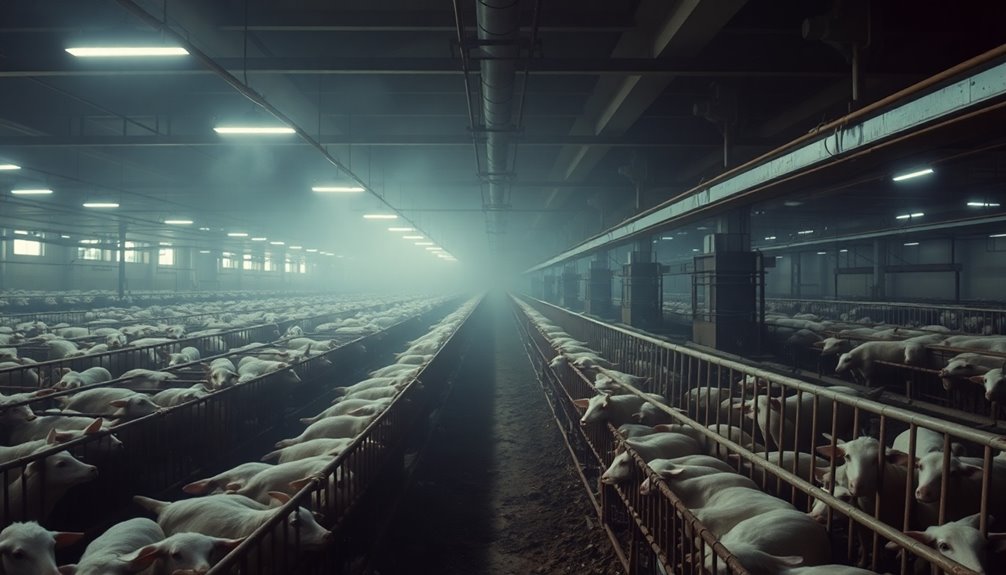
Factory farming, which has become the dominant method of food production in the U.S., raises serious concerns about animal welfare. In these industrial farms, animals raised for food are often confined in restrictive enclosures, severely limiting their natural behaviors.
This intense confinement leads to unsanitary conditions, increasing the risk of disease and infection. To combat these issues, farmers frequently administer antibiotics, which can contribute to the rise of antibiotic-resistant bacteria.
Additionally, painful mutilations, like tail docking and castration, are common practices performed without pain relief. The focus on maximizing output and minimizing costs often overshadows the basic welfare of these animals, resulting in a system that prioritizes profit over humane treatment.
Understanding these realities is essential for making informed choices about food consumption.
Animal Welfare Concerns
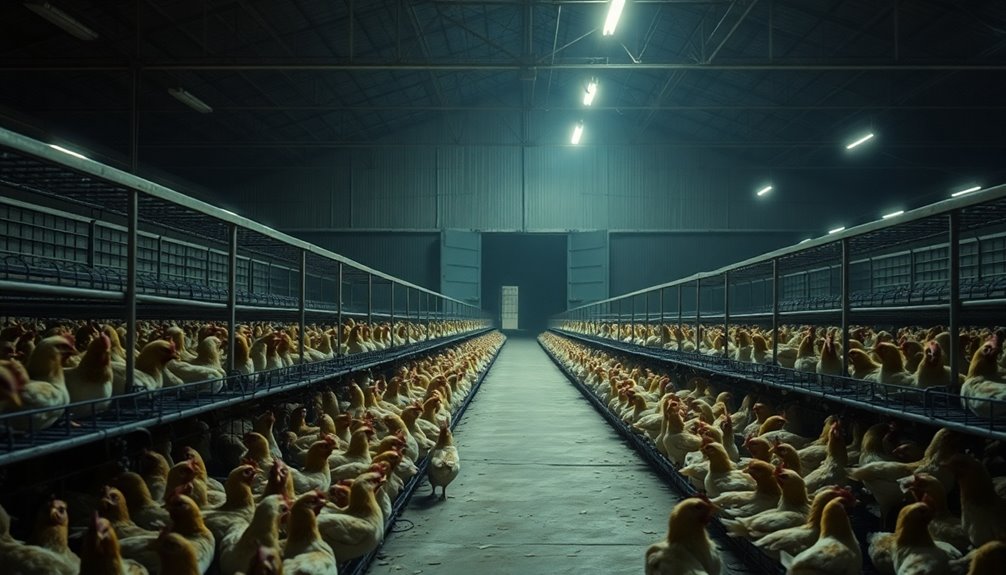
The conditions faced by animals in factory farming raise significant welfare concerns that demand attention. In these factory farms, approximately 99% of farmed animals are confined in small cages or crates, severely restricting their natural behaviors.
Practices like battery cages for hens and gestation crates for sows lead to stress, aggression, and abnormal behaviors. Many undergo painful alterations, such as tail docking and beak trimming, often without anesthesia, resulting in prolonged suffering.
The overuse of antibiotics addresses unsanitary conditions but also contributes to antibiotic resistance, posing risks to both animals and humans. Investigations reveal inhumane practices, highlighting the urgent need for improved animal welfare standards to guarantee that these animals are treated more humanely.
Environmental Impact
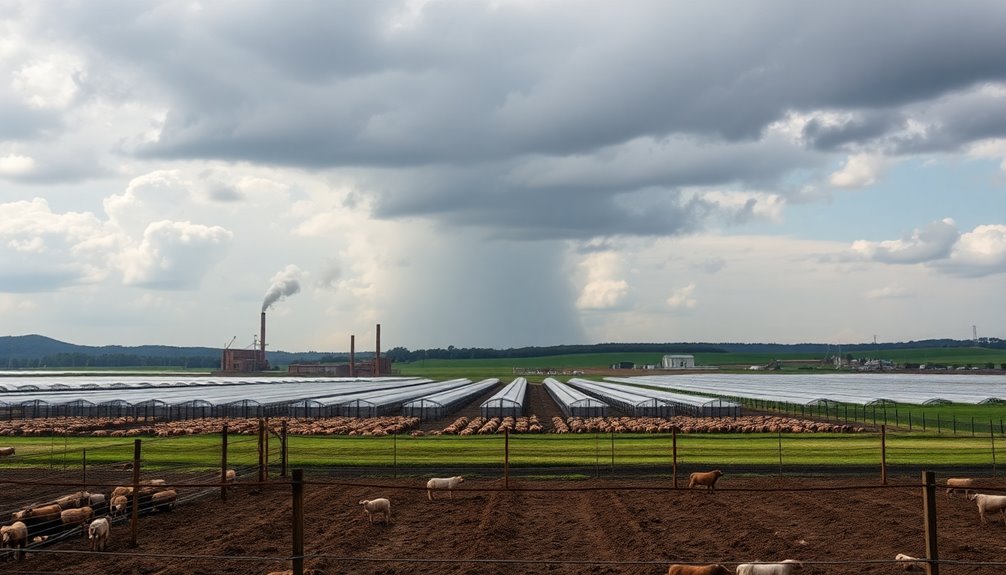
You might be surprised to learn that factory farming considerably contributes to water pollution and greenhouse gas emissions.
With massive amounts of manure produced by operations like CAFOs, overflow can contaminate local waterways.
Additionally, the methane and nitrous oxide released from livestock exacerbate climate change, highlighting the urgent need for change in agricultural practices.
Water Pollution Issues
Water pollution issues stemming from industrial agriculture are alarming, impacting ecosystems and human health. CAFOs often generate vast amounts of waste, leading to severe water pollution when manure lagoons overflow.
This pollution affects our waterways in several ways:
- Nutrient Runoff: Excessive chemical fertilizers leach into water bodies, causing eutrophication and harming aquatic ecosystems.
- Harmful Algal Blooms: Nutrient runoff can trigger algal blooms, resulting in aquatic dead zones, like those seen in Lake Erie.
- Antibiotics and Health Risks: Antibiotics used in CAFOs can contaminate water supplies, raising concerns about antibiotic-resistant bacteria affecting both humans and wildlife.
These issues highlight the urgent need for reform in industrial farming practices to protect our water resources.
Greenhouse Gas Emissions
Greenhouse gas emissions from industrial agriculture pose a significant threat to our environment and climate stability. Approximately 10% of total emissions come from this sector, with livestock production alone contributing around 65% due to methane and nitrous oxide released from manure and enteric fermentation.
Concentrated Animal Feeding Operations (CAFOs) generate vast amounts of manure, releasing methane that's 25 times more potent than carbon dioxide over a century. The excessive use of nitrogen-based fertilizers further amplifies nitrous oxide emissions, which are 298 times more effective at trapping heat.
Additionally, monoculture practices degrade soil, reducing its carbon sequestration capacity. This cycle of emissions exacerbates climate change, threatening food security and agricultural productivity for the future.
Health Risks Associated
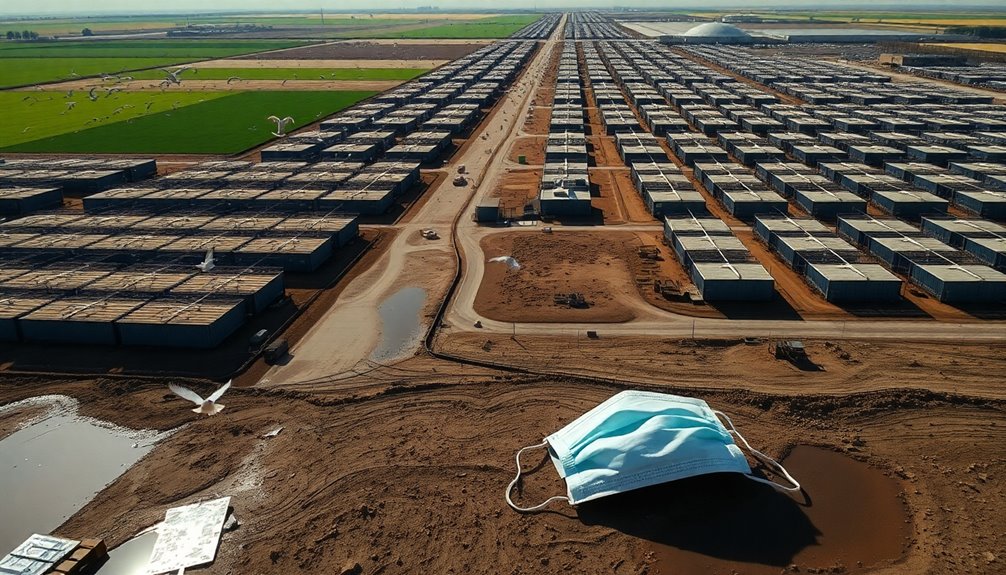
When you think about factory farming, you should consider the serious health risks it poses, particularly antibiotic resistance.
The overuse of antibiotics in these settings doesn't just affect animals; it can lead to resistant bacteria that impact your health through the food you eat.
Plus, water contamination from farming practices can put your safety at risk, making it essential to understand these risks.
Antibiotic Resistance Concerns
The widespread use of antibiotics in factory farming greatly heightens the risk of developing antibiotic-resistant bacteria, often referred to as superbugs.
These superbugs pose a significant public health threat, as they can contaminate soil and water supplies.
Here are some key points to reflect on:
- About 70% of all antibiotics sold in the U.S. are used in animal agriculture, mainly for growth promotion and disease prevention in overcrowded conditions.
- The CDC estimates that 2 million people in the U.S. contract antibiotic-resistant infections annually, resulting in at least 23,000 deaths.
- The WHO urges systemic changes in farming practices to reduce antibiotic use in animal agriculture, combating the rising threat of antibiotic resistance.
Your awareness can drive change for better health outcomes.
Water Contamination Issues
Factory farming considerably impacts water quality, posing serious health risks to communities nearby.
CAFOs generate an astonishing 369 million tons of manure annually, which can overflow into waterways, causing severe water contamination. Nutrient runoff from these operations, combined with industrial agriculture practices, results in pollution that degrades drinking water quality.
The overuse of antibiotics in CAFOs contributes to antibiotic-resistant bacteria contaminating soil and water supplies, leading to significant health risks for you and your family.
The excess nutrients can cause eutrophication, diminishing oxygen levels and resulting in fish kills, which disrupt local ecosystems.
If you live near factory farms, you may face increased exposure to contaminated water, potentially leading to gastrointestinal illnesses and chronic health conditions.
Economic Implications
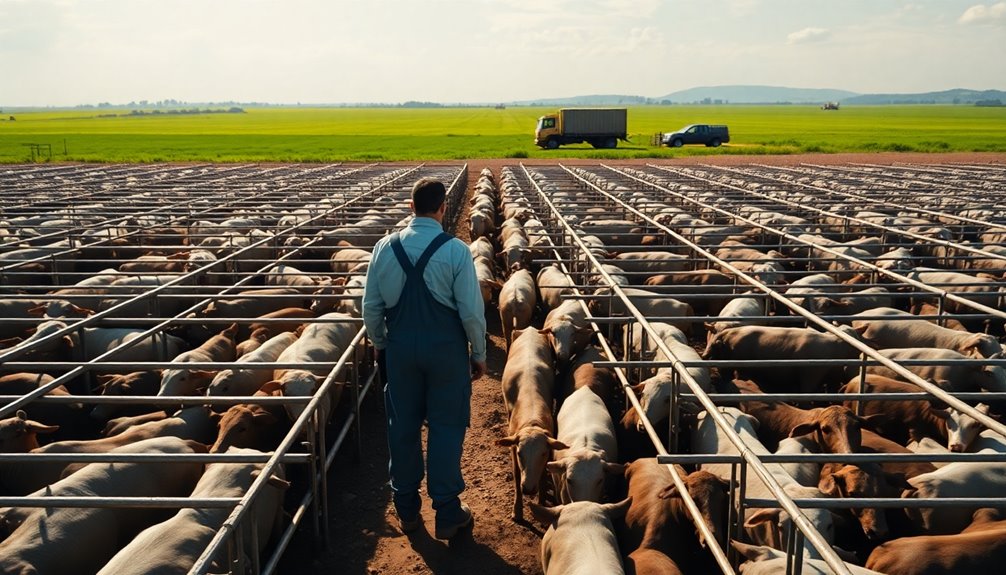
Corporate dominance in factory farming greatly shapes the economic landscape of agriculture in the U.S. This system prioritizes profit for large corporations while leaving farmers often struggling for economic stability.
Here's how factory farming impacts the economy:
- High Production Costs: Industrialized facilities drive down prices, making it tough for smaller farmers to compete.
- Contract Farming Pressures: Many farmers face contracts that force them to prioritize output over animal health, leading to cycles of debt.
- Decreased Market Prices: As supply increases, market prices drop, resulting in lower profits for farmers and workers.
Ultimately, these dynamics contribute to an unsustainable agricultural economy, threatening the livelihoods of those who grow our food.
Alternatives to Factory Farming
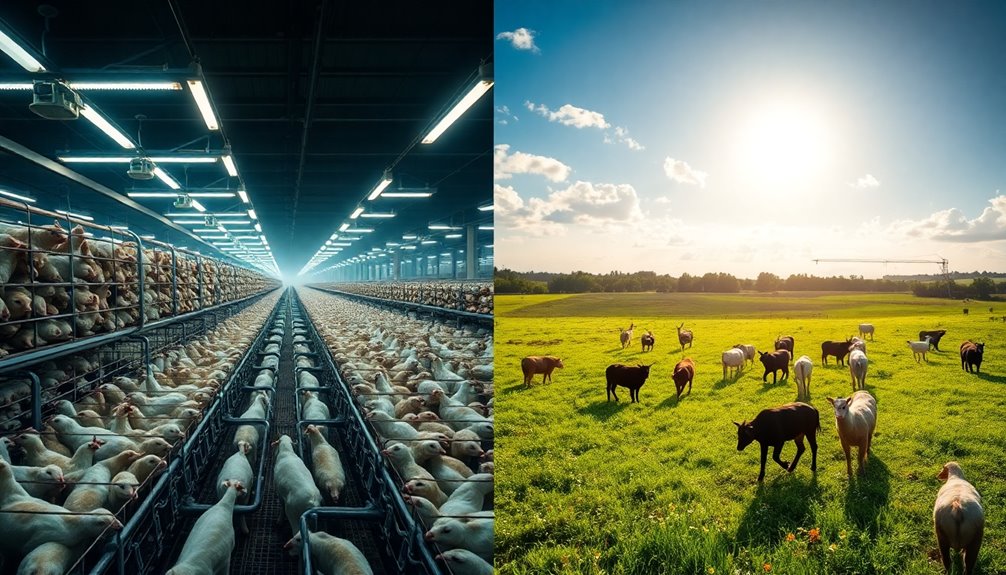
Exploring alternatives to factory farming reveals a range of sustainable practices that can transform our agricultural landscape.
Regenerative farming focuses on improving soil health, enhancing biodiversity, and promoting animal welfare through diverse crop rotations and low-confinement animal production.
Organic agriculture has gained traction, with sales skyrocketing as consumers seek sustainable food options.
By incorporating more plant-based foods into your diet, you can greatly reduce the demand for factory-farmed products.
Supporting local farms and community-supported agriculture (CSA) initiatives strengthens your connection with food producers while fostering a sustainable food system.
Embracing these sustainable farming practices not only enhances environmental integrity but also guarantees a kinder, healthier approach to agriculture for both people and animals. Additionally, many sustainable practices, such as eco-friendly materials, can also be applied to the production of educational toys, promoting a holistic approach to environmental responsibility.
Advocacy and Change
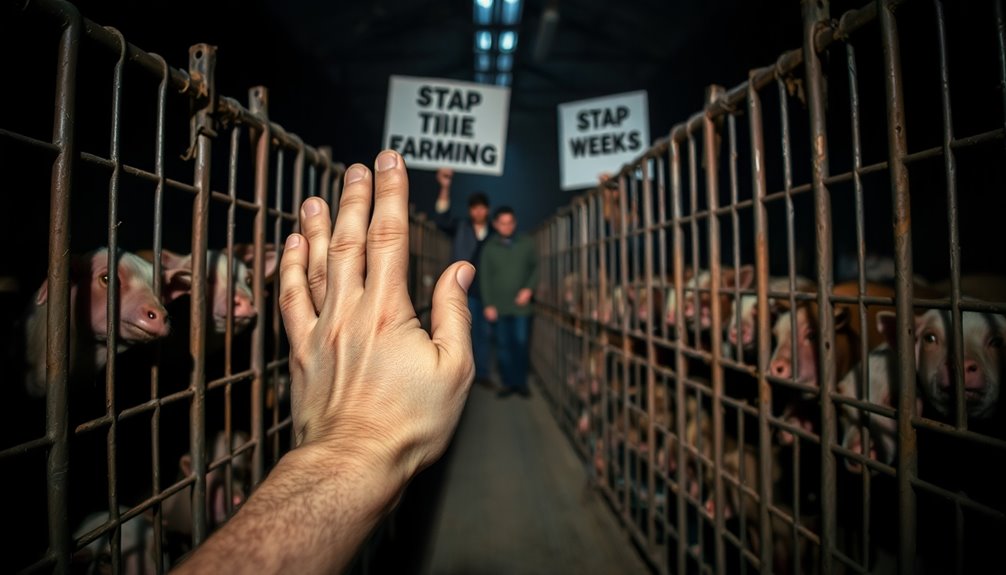
A growing movement advocates for humane farming practices, reflecting a significant shift in public attitudes toward animal welfare.
With 94% of Americans believing farm animals deserve freedom from abuse, it's clear that change is necessary.
You can contribute to this movement in several ways:
- Support higher-welfare farmers: Choose products from farms that prioritize humane treatment and sustainable agriculture.
- Reduce meat consumption: Incorporate more plant-based foods into your diet to lessen demand for factory-farmed animals.
- Engage in advocacy: Participate in community initiatives and support legislative reforms to combat animal suffering and promote anti-confinement laws.
Frequently Asked Questions
What Is Industrial Agriculture and Why Is It Bad?
Industrial agriculture involves large-scale farming of crops and livestock, often using chemical fertilizers and pesticides.
You mightn't realize, but this approach leads to significant environmental harm, like soil depletion and water pollution. It also promotes monoculture, reducing biodiversity and increasing greenhouse gas emissions.
The reliance on antibiotics in animal farming can create superbugs, posing health risks to you and your community.
What Is the Meaning of Factory Farming?
Imagine a cramped, dark space where countless animals live, unable to roam or even stretch. That's what factory farming means.
It's the large-scale production of livestock and crops, focusing on maximizing output while minimizing costs. Animals are often confined in small areas, leading to poor welfare and increased disease risk.
This system prioritizes efficiency over ethical treatment, raising concerns about health, environmental impact, and the future of farming practices.
What Is Factory Farming AP Human Geography?
In AP Human Geography, factory farming refers to large-scale agricultural practices that focus on maximizing production efficiency through intensive animal confinement.
You'll study how this system affects land use, rural economies, and food distribution.
You'll also explore the social, economic, and environmental impacts of these practices, including issues related to animal welfare, pollution, and public health.
Understanding these dynamics helps you grasp the broader implications of industrial agriculture in society.
What Is the Industrialization of Factory Farming?
The industrialization of factory farming refers to the large-scale, mechanized production of livestock, prioritizing efficiency and profit.
You'll notice that animals are often confined in overcrowded spaces, limiting their natural behaviors and movement.
This system relies heavily on antibiotics to maintain productivity, which can lead to antibiotic resistance.
Conclusion
To summarize, factory farming poses serious challenges to animal welfare, the environment, and our health. Did you know that over 90% of the meat consumed in the U.S. comes from these industrial farms? This staggering statistic highlights the need for change. By exploring alternatives and advocating for better practices, you can help shift the industry towards more humane and sustainable methods. Together, we can create a healthier planet and a more ethical food system for everyone.

